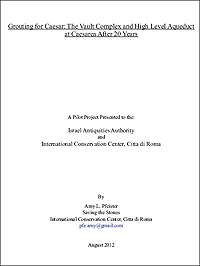The ancient city of Caesarea has great historic and international importance, is a popular tourist
attraction, a massive archaeological site, and a laboratory for conservation work. However, like
many such projects in Israel and abroad, its conservation project has yet to publish a final report.
The task is large and daunting and becomes more difficult with the passage of time, yet such a
report is beneficial for the site, those involved in the project, decision makers, and conservation
and related professionals around the world.
Conducted by the Israel Antiquities Authority (IAA) Conservation Department in the
1990s, the conservation and development of the archaeological site at Caesarea was the first
large-scale conservation project in Israel. The conservation of the High Level Aqueduct
(1991-1993) and Vault Complex (1993-1997) were particularly difficult engineering and
architectural tasks that required multiple processes and utmost care. This report documents and
analyzes the grouting method implemented at the Vault Complex and High Level Aqueduct.
After 20 years, the effectiveness of the treatment is ripe for assessment. Furthermore, this report
also serves as a pilot for the detailed implementation manual described in David Zell's (IAA)
manual entitled פיילוט מפרטים לשימור: אפיון צרכים ותוכנית עבודה לקידום הפרויקט , which aims to
standardize work reports in the field of conservation in Israel. Taken together, Zell’s manual and
this report present and embody a practical solution the problem of missing documentation and
final reports.
This report uses research, documentation, analysis, and comparison to connect the dots
between the condition of the Vault Complex and High Level Aqueduct at Caesarea upon
excavation and their current state. Since the project was carried out many years ago, much data
has been lost, scattered, or forgotten. Tangible documentation that remain comes from
individuals who worked on the project and the IAA storage lockers at Caesarea. Without a final
written report, oral communication with those involved in the archaeological and conservation
projects is also a vital source of information.
Not only does this report recount and describe the grouting procedures at Caesarea, but it
also analyzes their effectiveness via core drilling after 15-20 years. I compare the results of this
attraction, a massive archaeological site, and a laboratory for conservation work. However, like
many such projects in Israel and abroad, its conservation project has yet to publish a final report.
The task is large and daunting and becomes more difficult with the passage of time, yet such a
report is beneficial for the site, those involved in the project, decision makers, and conservation
and related professionals around the world.
Conducted by the Israel Antiquities Authority (IAA) Conservation Department in the
1990s, the conservation and development of the archaeological site at Caesarea was the first
large-scale conservation project in Israel. The conservation of the High Level Aqueduct
(1991-1993) and Vault Complex (1993-1997) were particularly difficult engineering and
architectural tasks that required multiple processes and utmost care. This report documents and
analyzes the grouting method implemented at the Vault Complex and High Level Aqueduct.
After 20 years, the effectiveness of the treatment is ripe for assessment. Furthermore, this report
also serves as a pilot for the detailed implementation manual described in David Zell's (IAA)
manual entitled פיילוט מפרטים לשימור: אפיון צרכים ותוכנית עבודה לקידום הפרויקט , which aims to
standardize work reports in the field of conservation in Israel. Taken together, Zell’s manual and
this report present and embody a practical solution the problem of missing documentation and
final reports.
This report uses research, documentation, analysis, and comparison to connect the dots
between the condition of the Vault Complex and High Level Aqueduct at Caesarea upon
excavation and their current state. Since the project was carried out many years ago, much data
has been lost, scattered, or forgotten. Tangible documentation that remain comes from
individuals who worked on the project and the IAA storage lockers at Caesarea. Without a final
written report, oral communication with those involved in the archaeological and conservation
projects is also a vital source of information.
Not only does this report recount and describe the grouting procedures at Caesarea, but it
also analyzes their effectiveness via core drilling after 15-20 years. I compare the results of this
testing on both Vault 1 and the High Level Aqueduct in respect to the effectiveness of grouting
methods and longevity of treatment as they were evidenced on 26 June 2012, then propose
possible reasons for the difference in results. Based on the analysis, this report concludes with
recommendations for future grouting procedures and work on grouted areas, including the
development and implementation of a maintenance plan for grouted areas that includes regular
monitoring over an extended period of time.
methods and longevity of treatment as they were evidenced on 26 June 2012, then propose
possible reasons for the difference in results. Based on the analysis, this report concludes with
recommendations for future grouting procedures and work on grouted areas, including the
development and implementation of a maintenance plan for grouted areas that includes regular
monitoring over an extended period of time.










